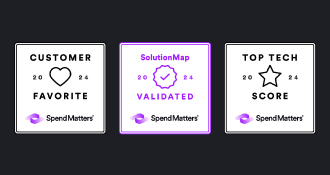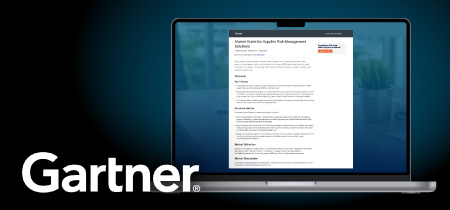On September 28th, 2020 Forbes Technology Council featured Mastering the ROI of Vendor Master Data Management, an article by Akhilesh Agarwal, COO & EVP, Global Procure to Pay Solutions & Applied Technology for apexanalytix. He presented ready-to-implement practices that will shore up a vendor master, ideas direct from his experience developing apexportal.
Akhilesh and his team are responsible for the 90 million supplier golden records, scored for accuracy, opportunity, and age, that are the foundation of apexportal, recognized by SpendMatters as a Value Leader in supplier management and risk for large companies.
Want more? Check these out:
- Webinar: How to Win the War Against Bad Master Data
- apexportal Demo Series
- Overview: Master Data Management Data Sheet
- Overview: MDM Build Vs. Buy
The original article follows. Reprinted with permission from Forbes Technology Council.
Imagine what would happen if hundreds or thousands of your supplier records were complete and up to date. What if this master data was free of duplicates and other errors? What if all your vendor records were protected from fraudulent entries?
The improvement would be immediate. A clean, reliable and common data set for all vendors enables you to make better sourcing decisions and eliminates fraud, fines and errors. Generally, it creates a more efficient sourcing operation.
Effective master data management (MDM) is a hallmark of growing businesses — poor data quality is no longer sustainable. Fortunately, new, automated strategies can help you get started and improve the ROI of MDM in your organization.
MDM Best Practices
Many businesses struggle with the sheer volume of supplier information, never mind keeping that data clean, secure and organized on an ongoing basis. The typical vendor master dataset is missing critical contact data, like email addresses, for 95% of its vendors, and 13% of entries contain bad tax IDs, according to my company’s analysis of vendor master data.
But data quality doesn’t improve on its own. Evaluate your MDM strategy, and consider the following best practices for achieving the maximum return on your data investments:
1. Master the existing master.
Your quickest opportunity for impact is in the dataset you already have. Compare your supplier master data with authoritative external sources of correct data — government databases, regulatory lists and other trusted entities — to identify gaps and errors. Think of this as data governance as a service.
Though it may be labor-intensive [unless software automation is leveraged] this endeavor can provide immediate ROI: Every corrected error and updated entry helps the organization operate more efficiently. Our data shows that a third of organizations — your competitors included — lack a regular process for cleaning data, and those that do have a process aren’t doing it often enough.
If this concept is foreign territory (“clean data” is a nebulous term at best), here are the pillars of the process to get you started:
Scrub: Get all vendor data in one place, and look for duplicates and errors, which are often uncovered in the consolidation process. Also, standardize company names, abbreviations, titles and other terminology so you can start with a clean set of data.
Validate: Confirm addresses, banking information, tax IDs and other critical data against government, regulatory and authoritative external sources. Additionally, complement the validation efforts by leveraging the entries in your rich supplier database.
Enrich: Go beyond the basics of filling in gaps like names and email addresses. Within all records, seek to add helpful context like corporate structures and other supplemental information.
Classify: Drill down on your existing data by adding SIC/NAIC codes and diversity status to help drive strategic procurement initiatives.
2. Establish clean data processes.
apexanalytix benchmarking found that the typical company adds 15% to 20% to its vendor master dataset each year. So, while putting your existing data house in order, you should also address your strategy for bringing in new data. Specifically, implement processes that ensure new data is complete and accurate before it is added.
As with many MDM issues, this is often easier said than done. For enterprises with hundreds of thousands of suppliers, if even 0.5% of records include an error, it adds up to big damage to data integrity and downstream decision making.
3. Remain vigilant.
MDM never ends. Data begins to decay immediately and requires frequent upkeep to achieve optimal benefits. So, it’s important to have mechanisms in place to continuously monitor external data sources to identify fraudulent entries, vendor mergers, regulatory risks or anything else that might require an update.
Without this step, you not only negate the efforts of the first two steps, but you also put your organization at risk. Fraudsters and bad actors can easily take advantage of an outdated vendor email list to execute sophisticated attacks, like sending fake invoices through spoofing and other business email compromise (BEC) scams.
Cybercrime, on the whole, has jumped 200% to 300% during the pandemic. While companies tend to think the biggest threat is a direct attack on their email systems, supplier email environments can also be hacked, allowing bad actors to divert supplier payments to their accounts. Future-proofing any MDM strategy must include taking the time to get vendor data correct and airtight.
A future-proofed MDM strategy always includes vigilance to ensure you have the most up-to-date vendor data.
Final Thoughts
Better MDM takes time, effort and domain expertise. Too often, when companies use traditional multidomain MDM toolkits to support vendor data. The required time investment causes organizations to cut corners or ultimately abandon their MDM endeavors.
If you feel overwhelmed by the idea of a robust MDM strategy, you’re not alone. Even the most agile IT teams struggle with the intricacies and upkeep required for a truly optimal vendor master. That’s why data stewardship as a service has made a difference in the enterprise. The right partner can clean, enrich and continuously monitor your vendor master and provide tools that support spend analytics and fraud prevention.
An effective vendor MDM strategy shouldn’t be a fantasy or a task that lives on the back burner — think of it as a new service you can access to reap the benefits that better data management can offer your organization.

About Akhilesh
Akhilesh Agarwal leads the apexanalytix solutions practice responsible for apexportal, the industry’s only 100 percent touchless solution for global supplier information management and working capital optimization. He leads the development of new client-focused software innovations, guided by the regular trend analyses he conducts to ensure that apexportal delivers real-world efficiency and productivity benefits. He also oversees pre-sales, product management, project planning and reviews, risk mitigation and the delivery of seamless solutions to large global clients across country borders.
Akhilesh has an extensive background in product design and execution in accounts payable, accounts receivable and related areas. Before joining apexanalytix, he was vice president of technology for iQor, a provider of intelligent customer interaction solutions, where he earned a reputation there for consistently delivering on high-visibility, high-performance projects. He is also a former associate director of software development for Receivable Management Services and a former project manager for Aditya International.






